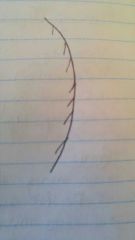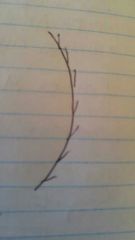![]()
![]()
![]()
Use LEFT and RIGHT arrow keys to navigate between flashcards;
Use UP and DOWN arrow keys to flip the card;
H to show hint;
A reads text to speech;
94 Cards in this Set
- Front
- Back
|
The process of removing heavy metals from contaminated soils by adding an acid solution to the soil and catching the solution that drains through |
Acid precipitation |
|
|
A measure of how much Sun's radiation is reflected by a surface |
Albedo |
|
|
The positive feedback loop in which an increase ib Earth's temperature causes ice to melt, so more radiation is absorbed by Earth's surface, leading to further increases in temperature. |
Albedo effect |
|
|
The third phase of mitosis in which the centromere splits and sister chromatids separate into daughter chromosomes, and each moves toward opposite ends of the cell. |
Anaphase |
|
|
Resulting from human influence |
Anthropogenic |
|
|
Undifferentiated cells at the tips of plant roots and shoots; cells that divide, enabling the plant to grow longer and develop specialized tissues. |
Apical meristem |
|
|
The depth that an object appears to be at , due to the refraction of light in a transparent medium |
Apparent depth |
|
|
An aqueous solution that conducts electricity and turns red litmus blue |
Base |
|
|
The technology of using light energy to diagnose, monitor, and treat living cells and organisms |
Biophotonics |
|
|
A model representing the arrangement of electrons in orbits around the nucleus of an atom |
Bohr - Rutherford diagram |
|
|
The ability of a substance to resist changes in pH |
Buffering capacity |
|
|
Any environmental factor that causes cancer |
Carcinogen |
|
|
The process by which a cell becomes specialized to perform a specific function |
Cellular differentiation |
|
|
The structure that holds chromatids together as chromosomes |
Centromere |
|
|
The rapid reaction of a substance with oxygen to produce oxides and energy; burning |
Combustion |
|

Convex/concave |
Convex |
|

Convex/concave |
Concave |
|
|
A specialized tissue that provides support and protection for various parts of the body |
Connective tissue |
|
|
A bond that results from the sharing of outer electrons between non metal atoms |
Covalent bond |
|
|
A layer of wax on the upper and lower surfaces of a leaf that blocks the diffusion of water and gases |
Cuticle |
|
|
The stage in the cell cycle when the cytoplasm divides to form 2 identical cells; the final part of cell division |
Cytokinesis |
|
|
The stage in the cell cycle when the cytoplasm divides to form 2 identical cells; the final part of cell division |
Cytokinesis |
|
|
The tissues covering the outer surface of the plant |
Dermal tissue system |
|
|
A molecule consisting of only 2 atoms of either the same or different elements |
Diatomic molecule |
|
|
A compound that seperates into ions when it dissolves in water, producing a solution that conducts electricity |
Electrolyte |
|
|
A thin sheet of tightly packed cells that covers body surfaces and lines internal organs and body cavities |
Epithelial tissue |
|
|
Steel that has been coated with a protective layer of zinc which forms a hard insoluble oxide |
Galvanized steel |
|
|
One of a pair of special cells in the epidermis that surround and control the opening and closing of each stomate |
Guard cell |
|
|
Combustion resulting in CO, C, carbon dioxide, soot, waterand energy - happens when oxygen supply is limited |
Incomplete combustion |
|
|
The phase of the cell cycle during which the cell performs its normal functions and its genetic material is copied in preparation for cell division |
Interphase |
|
|
The simultaneous strong attraction of positive and negative non metal ions |
Ionic bond |
|
|
A compound made up of an anion and cation |
Ionic compound |
|
|
The statement that in any given chemical reaction the total mass of the reactants equals the total mass of the products |
Law of the conservation of mass |
|
|
Light produced as a result of an electric current flowing in semiconductors |
Light emitting diode (LED) |
|
|
Any physical substance through which energy can be transferred |
Medium |
|
|
An undifferentiated plant cell that can divide and differentiate to form specialized cells |
Meristematic cell |
|
|
The 2nd stage of mitosis in which the chromosomes line up in the middle of the cell |
Metaphase |
|
|
The process of cancer cells breaking away from the original tumour and establishing another tumour elsewhere in the body |
Metastasis |
|
|
A virtual image that forms as a result of refraction and total internal reflection in Earth's atmosphere |
Mirage |
|
|
Any polished surface reflecting an image |
Mirror |
|
|
The stage of the cell cycle in which the DNA in the nucleus is divided the first part of cell division |
Mitosis |
|
|
A particle in which atoms are joined by covalent bonds |
Molecule |
|
|
The inability of the eye to focus light from distant objects near sightedness |
Myopia |
|
|
A modified form of the diverging lens shape |
Negative meniscus |
|
|
Specialized tissue that conducts electrical signals from one part of the body to another |
Nerve tissue |
|
|
A nerve cell |
Neuron |
|
|
A chemical reaction in which an acid and a base react to form an ionic compound (salt) and water the resulting pH is closer to 7 |
Neutralization reaction |
|
|
Point at the exact centre of the lens |
Optical centre |
|
|
A structure composed of different tissues working together to perform a complex body function |
Organ |
|
|
A layer of tall, closely packed cells containing chloroplasts just below the upper surface of a leaf a type of ground tissue |
Palisade layer |
|
|
Tissue on the surface of a plant that produces bark on the stems and roots |
Periderm tissue |
|
|
A row of elements in the periodic table |
Period |
|
|
The part of the nervous system consisting of the nerves that connect the body to the central nervous system |
Peripheral nervous system |
|
|
Vascular tissue in plants that transports dissolved food materials and hormones throughout the plant |
Phloem |
|
|
The process of producing light by the absorption of UV Light resulting in the emission visible light over an extended period of time |
Phosphorescense |
|
|
An ion made up of more than 1 atom that acts as a single particle |
Polyatomic ion |
|
|
A modified form of the converging lens shape |
Positive meniscus |
|
|
A form of far sightedness causes by a loss of accommodation as a person ages |
Presbyopia |
|
|
The line through the centre of curvature to the midpoint of the mirror |
Principal axis |
|
|
The first stage of mitosis in which the chromosomes become visible and the nuclear membrane dissolves |
Prophase |
|
|
A method of energy transfer that does not require a medium the energy travels at the speed of light |
Radiation |
|
|
An image that can be seen on a screen as result of light rays actually arriving at the image location |
Real image |
|
|
The bouncing back of light from a surface |
Reflection |
|
|
The bending or change in direction of light when it travels from one medium to another |
Refraction |
|
|
An optical device in which the emergent ray is parallel to the incident ray |
Retro reflector |
|
|
The system in a flowering plant fern or conifer that anchors the plant absorbs water and minerals and stores food |
Root system |
|
|
A reaction in which an element displaces another element in a compound and a new element |
Single displacement reaction |
|
|
Reflection of light off a smooth surface |
Speculat reflection |
|
|
A region of loosely packed cells containing chloroplasts in the middle of a leaf a type of ground tissue |
Spongy mesophyll |
|
|
An undifferentiated cell that can divide to form specialized cells |
Stem cell |
|
|
An opening in the surface of a leaf that allows the exchange of gases |
Stomate |
|
|
A reaction in which 2 reactants combine to make a larger or more complex product A + B -> AB |
Synthesis reaction |
|
|
The final phase of mitosis in which the chromatids unwind and a nuclear membrane reforms around the chromosomes at each end of the cell |
Telophase |
|
|
The situation when the angle of incidence is greater than the critical angle |
Total internal reflection |
|
|
The production of light from friction as a result of scratching crushing or rubbing certain crystals |
Triboluminescense |
|
|
A form of invisible higher energy radiation |
Ultraviolet radiation |
|
|
The tissues responsible for conducting materials within a plant |
Vascular tissue system |
|
|
The point where the principal axis meets the mirror |
Vertex |
|
|
A blood vessel that returns blood to the heart |
Vein |
|
|
An image formed by light coming from an apparent light source light is not arriving at or coming from the actual image location |
Virtual image |
|
|
The continuous sequence of colours that make up white light |
Visible spectrum (ROYGBIV) |
|
|
The process of transplanting an organ or tissue from 1 species to another |
Xenotransplantation |
|
|
Vascular tissue in plants that transports water and dissolved minerals from the roots to the leaves and stems of the plant |
Xylem |
|
|
Reflection of light off an irregular or dull surface |
Diffuse reflection |
|
|
The seperation of white light into its constituent colours |
Dipersion |
|
|
A lens that is thinnest in the middle and that causes incident parallel light rays to spread apart after refraction |
Diverging lens |
|
|
A lens that is thickest in the middle and that causes incident rays to converge through a single point after refraction |
Converging lens |
|
|
A mirror shaped like part of the surface of a sphere in which the inner surface is reflective |
Concave mirror |
|
|
A mirror shaped like part of the surface of a sphere in which the outer surface is reflective |
Convex mirror |
|
|
The angle of incidence that results in an angle of refraction of 90° |
Critical angle |
|
|
The part of the nervous system consisting of the brain and the spinal cord |
Cental nervous system |
|
|
The centre of the sphere whose surface has been used to make the mirror |
Centre of curvature |
|
|
The light ray that leaves a lens after refraction |
Emergent ray |
|
|
The point at which light rays parallel to the principal axis converge when they are reflected off a concave mirror |
Focus |

